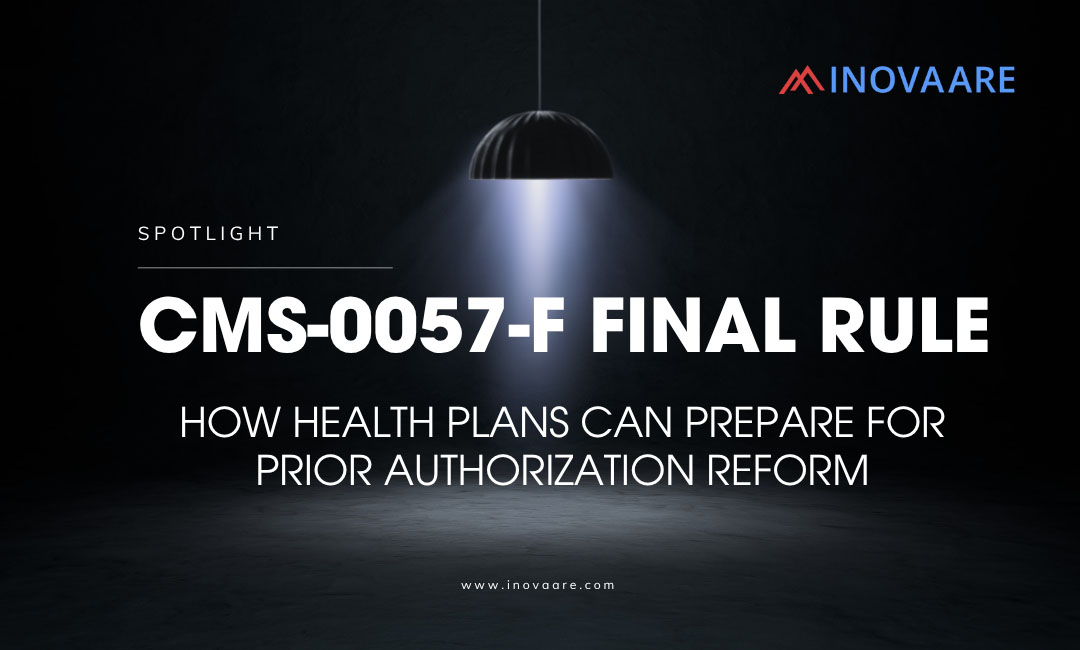The CMS-0057-F Final Rule, published in early 2024, isn’t just another regulatory update. Instead, it marks a fundamental reset in how payers manage data, prior authorization, and interoperability. Health plans participating in Medicare Advantage, Medicaid Managed Care, CHIP, or the ACA Marketplace must comply with multiple mandates by 2026–27.
Moreover, this isn’t a surface-level change. Rather, CMS-0057-F demands operational rewiring, not just policy updates. To comply successfully, payers need systems that are transparent, API-driven, and capable of real-time tracking, while also improving member and provider experiences.
“CMS-0057-F is forcing a shift from static compliance checklists to live, operational accountability. Health plans that align their operations, data, and decision-making with these mandates won’t just stay compliant, they’ll lead.”

Compliance Officer, Inovaare
Who does CMS-0057-F apply to?
The rule applies to:
- Medicare Advantage Organizations (MAOs)
- Medicaid Managed Care Plans
- CHIP Managed Care Entities
- Qualified Health Plan (QHP) Issuers on Federally Facilitated Exchanges
If you fall into any of these categories, the time to act is now.
5 Core Mandates of CMS-0057-F
| Requirement | Summary | Strategic Impact |
|---|---|---|
| Provider Access API | Share claims, clinical, encounter, and cost data with in-network providers via FHIR API | Enables timely, informed care delivery and strengthens provider alignment |
| Patient Access API (Expanded) | Includes prior auth, claims, provider directories, formulary data | Improves member self-service and transparency |
| Electronic Prior Authorization API | Real-time electronic prior auth with 72h/7d turnaround deadlines + reasons for denial | Streamlines utilization management and avoids regulatory penalties |
| Payer-to-Payer Data Exchange | Auto-share clinical and claims data when a member changes plans | Ensures continuity of care and reduces duplicate procedures |
| Public Reporting of Prior Auth Metrics | Requires publication of prior auth approval/denial rates, turnaround times | Exposes payer performance to consumers and CMS oversight |
Compliance Deadlines and Timeline (As of 2024 Final Rule)
| Requirement | Effective Date |
|---|---|
| Provider Access API | Data must be available by January 1, 2027 |
| Patient Access API (expanded) | Enforcement begins January 2026 |
| Electronic Prior Authorization API | Compliance required by January 2026 |
| Public Reporting (Prior Auth Metrics) | Reporting begins for Plan Year 2026 |
| Payer-to-Payer Data Exchange | Required starting January 2026 |
Pro Tip: Begin implementation by mid-2025 to meet testing, certification, and audit preparation needs.
Why payers can’t afford to delay
Non-compliance isn’t just a regulatory risk, it’s a reputational and operational liability. Delaying action now could lead to long-term setbacks across your organization. Here’s what’s at stake:
- First, delays or failures to comply may trigger CMS audits, penalties, or sanctions.
- Second, poor prior authorization metrics will be publicly visible, to members, regulators, and competitors alike.
- Without automation, manual reviews will pile up, increasing turnaround times and straining internal resources.
- Moreover, providers expect real-time access. Gaps in data sharing will erode trust and weaken network relationships.
- Modernized plans will win loyalty. Those lagging behind risk churn.
How to prepare for CMS-0057-F: Step-by-step compliance playbook
The CMS-0057-F Final Rule doesn’t leave room for partial compliance. It’s comprehensive, technical, and public-facing, with the potential to disrupt workflows, technology stacks, and member relationships unless addressed systemically.
To stay ahead, payer compliance leaders must drive readiness not only through checklists, but also by building institutional muscle across departments.
1. Start with a Gap Assessment: Before implementation comes introspection. First, you need to baseline where your organization stands in relation to the five core mandates, particularly around FHIR APIs, prior authorization turnaround, and data interoperability.
Action: Conduct a CMS-0057-F gap assessment involving Compliance, IT, UM, and Reporting teams. Ask the following:
- Are our FHIR APIs live and production-grade?
- Are prior auth SLAs being tracked in real time?
- Can we exchange data when members change plans?
2. Build a Cross-Functional CMS-0057-F Compliance Task Force: This is not a project for IT or Compliance alone. Instead, it’s an enterprise mandate across Compliance and Audit, Interoperability / IT Architecture, Utilization Management (UM), Provider Operations, Legal and Privacy, and Reporting / Regulatory Affairs.
Action: Assign a compliance lead with executive sponsorship. In addition, establish shared timelines, milestones, and reporting dashboards.
3. Map and Redesign Prior Authorization Workflows: CMS mandates a turnaround of 7 days for standard requests and 72 hours for expedited ones, along with clear reasoning for all denials. Therefore, you must re-map your prior authorization workflows to meet these expectations.
Action: Build logic-based workflows that can auto-validate medical necessity and reduce review burden.
- First, identify every step in your current prior auth process: intake, review, decision, notification
- Next, flag manual steps, delays, and non-standardized denial language
- Finally, consider integrating an ePA engine to streamline the process
4. Build and Test FHIR-Compliant APIs: This is the backbone of CMS-0057-F. APIs must not only comply with HL7 FHIR R4 standards, but they must also be secure, auditable, uptime-monitored, and scalable to support growing data volumes and complex use cases.
Action:
- First, evaluate current Patient and Provider Access APIs, are they production-grade?
- Next, plan deployment of the Provider Access API, due by Jan 2027
- Then, begin testing with a controlled group of in-network providers
5. Establish Consent, Identity, and Access Governance: Sharing sensitive member data with providers and other payers brings new compliance risks. Therefore, strong governance is essential. You need verifiable consent capture, robust member authentication, reliable access logs with time stamps, and processes for revocation.
Action:
- Start by partnering with Legal and InfoSec to define boundaries and controls.
- Then, implement access request logging tied to APIs
- Finally, prepare for auditable data trails that CMS may require on inspection
6. Prepare for Public Metrics Reporting: Beginning in 2026, CMS will require all plans to publicly post prior authorization metrics, including volume of requests, turnaround performance, approval/denial ratios, and reasons for denials. Even a single year of poor metrics can damage member trust and impact STAR ratings.
Action:
- Begin now by running dry runs of CMS-required reports
- Track and analyze denial rates, turnaround times, and approval trends.
- Proactively investigate any outliers before CMS or the public does.
- Also, identify whether the gaps originate from internal processes or third-party vendors.
7. Prepare for Payer-to-Payer Data Exchange: Every time a member switches plans, you are required to exchange claims, clinical records, and prior authorization data. However, your compliance won’t hold up if your data format or responsiveness falls short of industry expectations. Delays in exchange disrupt continuity of care, and CMS will not overlook them.
Action:
- First, create workflows that include identity verification and transfer receipts.
- Then, map your relationships with the most common sending and receiving payers.
- Finally, use staging environments to test both inbound and outbound data payloads for accuracy and speed.
8. Monitor in Real Time: You can’t fix what you can’t track. Instead of waiting for reports, build systems that provide real-time visibility. When metrics are visible and shared, compliance becomes embedded in your culture, not just in documentation.
Action: Create a CMS-0057-F command center with live dashboards to monitor API uptime and failures, prior auth SLAs, consent transaction logs, and reporting readiness
9. Train Internally and Align Vendors: CMS-0057-F compliance extends beyond technology, it depends on people. You’ll need internal understanding and external accountability. Providers must be informed, member services must know what’s accessible via APIs, and vendors must align to your SLAs.
Action:
- Distribute CMS-0057-F readiness briefs tailored by department.
- Incorporate CMS-0057-F into training programs and onboarding materials.
- Assign mandate champions to lead internal compliance for each functional area.
10. Operationalize and Audit Quarterly Until Enforcement: Intent won’t protect you, CMS will evaluate based on results. From API functionality to SLA monitoring and data reporting, compliance will be assessed on hard evidence. So, build resilience now, don’t wait for an audit to react.
Action:
- Conduct quarterly internal audits of CMS-0057-F readiness across departments.
- Validate that API payloads, logs, and member disclosures meet regulatory standards.
- Maintain a live issue tracker with owner assignments, resolution dates, and status transparency.
What health plan compliance officers must champion
| Action Item | Departmental Lead |
|---|---|
| CMS-0057-F Compliance Committee | Compliance Officer |
| API Implementation & Interop | CIO / IT Interoperability Lead |
| Prior Auth Automation & Denial Reasoning | Medical Director / UM |
| Reporting Infrastructure | Analytics / Reporting / Regulatory Affairs |
| Legal and Consent Governance | Legal, Risk & Privacy Teams |
How Inovaare Supports CMS-0057-F Compliance
Inovaare’s AI-enabled HIPAA compliant Health Cloud Platform helps payers meet and exceed CMS-0057-F requirements with:
- FHIR-ready API solutions (Provider Access, Patient Access, Prior Auth)
- Consent and data governance modules
- Compliance monitoring dashboards for audit readiness
- Reporting accelerators for CMS prior auth metrics
Payers that succeed under CMS-0057-F won’t just check the compliance box, they’ll rewire their operations with real-time data, streamlined workflows, and transparent care delivery.
Get future-ready, not just compliant. Learn more
